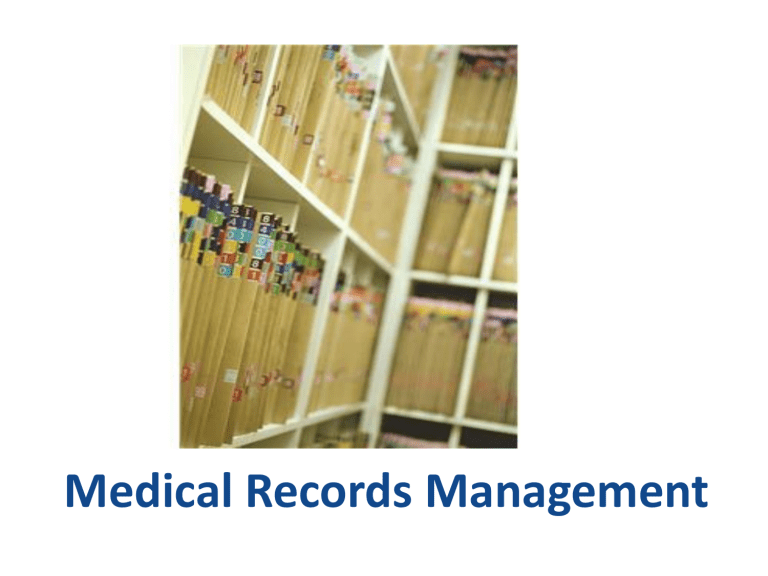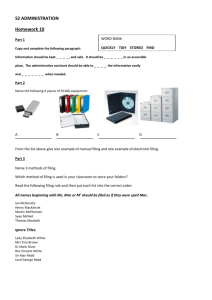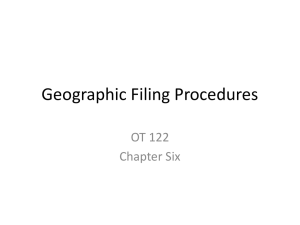Medical Records Management

Medical Records Management
Medical Records
• Where should medical records be kept?
• How long are the records kept?
2
Points to Remember
• Medical records must be kept confidential and in a secured, locked location.
• The record should never leave the medical facility in which it originated, except for legal reasons.
3
Medical Record
• What is placed into the patient’s medical record?
4
Ownership of the
Medical Record
• Who owns the medical record?
5
Ownership of the
Medical Record
• Patients own the content and have a right of access to the information in the record.
6
Authorization to
Release Information
• Patient must give written permission
• 1 year time limit if not otherwise stated
• Only requested information may be released
• Released information never includes insurance or financial information
7
Organization of the
Medical Record
What are Source-Oriented Medical
Records (SOMR)?
8
Source-Oriented
Medical Records (SOMR)
• Traditional method of keeping patient records.
• Information filed according to their sources
– Separate sections for laboratory reports, x-ray films, radiology reports, and so on.
• Forms and progress notes are filed in reverse chronologic order (newest on top).
9
Organization of the
Medical Record
What are Problem-Oriented Medical
Records (POMR)?
10
SOAP Notes
What do these stand for?
• S
• O
• A
• P
11
SOAP Notes
• S – Subjective – what patient says
• O – Objective – what you see/hear
• A – Assessment – diagnosis
• P – Plan - treatment
12
6 C’s of Charting
• Client’s own words
• Clarity (Clear)
• Completeness
• Conciseness
• Chronological order
• Confidentiality
13
Charting
• Can you chart for someone else?
• Why are we conscious of using correct medical terminology when charting?
• Why do we use correct grammar and punctuation?
14
Charting
• How do you correct an error that you made while charting?
15
Correcting a Medical Record
1.
Draw a single line through error
2.
Make correction in chart above error
3.
Write “ Corr ” or “correction” in the margin
4.
Date and initial
What is done for electronic records?
16
Correcting Electronic Records
• If an error is made while typing, simply backspace and correct the error.
• If the error is discovered later, make an additional entry with corrected information.
• Do not delete or change previous entries on electronic records.
17
Equipment & Supplies
18
Equipment & Supplies
Outguides
19
Basic Rules for Filing
Which of these names is filled first in alphabetical order?
Patricia A. McColm
Patricia H. McColm
20
Basic Rules for Patient Filing
Rule 1 : Last name, first name, middle name
Example: 1 2 3
Obama Barack Hussein
21
Basic Rules for Filing
Rule 2: Initial used as a legal name is filed as a name
Example: 1 2 3
Eliot, T. S. Elliott T. S.
22
Basic Rules for Filing
Rule 3: Foreign prefixes or abbreviations become one unit with the last name
Example:
Lisa M. Del Vecchio
Jill A. St. John
1 2 3
Delvecchio Lisa M
Stjohn Jill A
23
Basic Rules for Filing
• Rule 4 – Hyphenated names are considered one unit
George M. Andrews-Scott becomes
1 2 3
Andrews-Scott George M
24
3 Major Filing Methods
1.
Alphabetic – What is it?
2.
Numeric – What is it?
3.
Subject – What is it?
C o l o r C o d i n g (used in all 3 major systems)
◦
Each letter is assigned a different color
◦
Each folder given a color-coded label
◦
Only full-cut folders are used
25
• What is it?
Tickler File
• How does a computer do this?
26
Project 3 – Week 7
• There are two essays:
• Download documents from DocSharing
• Make two cover sheets – one for Part I and one for Part II essay
• 1 – 2 pages in length (300 words)
• Must have a reference citation in both
• There is a filing exercise.
• Look for the announcement entitled
Unit 7: Project 3 Information!
27




![STATE OF NEW JERSEY SENATE, No. 2211 211th LEGISLATURE [First Reprint]](http://s2.studylib.net/store/data/013324726_1-7e43b109b52ea09adb213390f350b3ae-300x300.png)